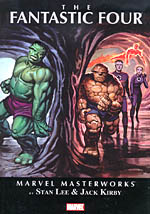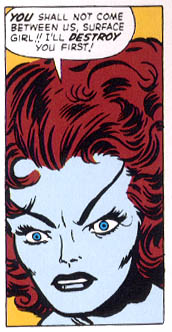 Written by Stan Lee
Written by Stan Lee
Penciled by Jack Kirby
Inked by Dick Ayers and Steve Ditko
304 pages, color
Published by Marvel Comics
Stan Lee and Jack Kirby’s 102-issue run on Fantastic Four is fairly legendary, and with so many options now available to read those original issues (hardcover and softcover full-color Marvel Masterworks reprints, plus black and white Essential Fantastic Four volumes) it seemed like a good a time as any to start catching up on my Marvel history. Like my recent dip into Marvel Masterworks: The Avengers, though, I found a fairly wide range of material here; some good, some extremely dated.
With this run of issues on Fantastic Four (#11-20, plus Annual #1), Stan Lee and Jack Kirby are already starting to branch out and pull away from the sameness that permeated a lot of the first ten issues of the series. Instead of repeated appearances by Namor and Doctor Doom, we start getting some new villains brought onto the scene, like the Red Ghost, the Mad Thinker, Rama-Tut, and the Impossible Man. New faces are ultimately essential for Fantastic Four at this stage in the game; the book is at its most interesting when it’s going for something big and crazy, and another appearance by the same foe rarely brings that to the table. When Namor and Doctor Doom do appear, here, they’re actually some of the least interesting stories in the volume.
 I appreciate that the Fantastic Four comics here often have the team winning through out-thinking their opponents rather than simply smashing them to bits. With the Thing and the Human Torch, there’s certainly a lot of firepower on the team, so a simple bust-em-up ending wouldn’t be out of the realm of possibility. But even when the out-thinking solution feels a little too random or out of the blue (like in the case of the Mad Thinker), it’s still preferable to a simple punch to the head providing the answer. Stories like the team going up against Molecule Master and the Impossible Man are two of the best examples of that here, providing a logical series of steps for the Fantastic Four to remain victorious.
I appreciate that the Fantastic Four comics here often have the team winning through out-thinking their opponents rather than simply smashing them to bits. With the Thing and the Human Torch, there’s certainly a lot of firepower on the team, so a simple bust-em-up ending wouldn’t be out of the realm of possibility. But even when the out-thinking solution feels a little too random or out of the blue (like in the case of the Mad Thinker), it’s still preferable to a simple punch to the head providing the answer. Stories like the team going up against Molecule Master and the Impossible Man are two of the best examples of that here, providing a logical series of steps for the Fantastic Four to remain victorious.
On the other hand, there is an extraordinary amount of deus ex machina on display in Marvel Masterworks: Fantastic Four Vol. 2. The books seems to regularly write itself into a corner, and then have to resort to the ridiculous in order to wrap things up. The Rama-Tut issue is probably the worst offender in that category, between a completely random "the Egyptian sun and some radiation somehow changes the Thing back into human form" sequence, and then the reasoning for why they can’t use the discovered cure for blindness on Alicia Masters. Either one of these moments would feel like a cheat, but paired together it’s cringe worthy. Even a story that uses good logical steps, like the Molecule Master issue, often resorts to a sudden last-second deus ex machina (in this case the Watcher cleaning up the mess and keeping the team from another confrontation with the villain) so that everything is reset back to normal.
 In the introduction to this volume, Stan Lee says one of his goals was to make the Invisible Girl an essential part of the team here, but I’m afraid I’m just not seeing it. She still comes across depressingly ineffectual, her powers used more often than not to hide above all else. With such a passive power set it’s easy to see why later issues expanded her abilities (to turn other things invisible and also to project force shields), but it’s a shame that the only character motivation that stick out for her is the developing love triangle between her, Reed, and Namor. The boys aren’t exactly the most three-dimensional characters either, but poor Sue is left holding the short end of the stick.
In the introduction to this volume, Stan Lee says one of his goals was to make the Invisible Girl an essential part of the team here, but I’m afraid I’m just not seeing it. She still comes across depressingly ineffectual, her powers used more often than not to hide above all else. With such a passive power set it’s easy to see why later issues expanded her abilities (to turn other things invisible and also to project force shields), but it’s a shame that the only character motivation that stick out for her is the developing love triangle between her, Reed, and Namor. The boys aren’t exactly the most three-dimensional characters either, but poor Sue is left holding the short end of the stick.
Still, Kirby’s pencils look dynamite here, there’s no doubt about that. He draws such wonderful, expressive characters, and that’s not limited to just the leads. Minor characters like Dorma (looking mightily pissed-off) and the Thinker (the perfect depiction of a schemer) are given just as much attention, and in general everyone’s got a lot of energy and power. Even simple things like a right on the Moon against the Red Ghost and his apes look awesome, here, or something as normal as Sue sitting on a lounger while talking to the rest of the team. Kirby is an artist whose works I came to appreciate over time, and now that I’m seeing his work here with fresh eyes it looks that much more exciting and imaginative.
Master Masterworks: Fantastic Four Vol. 2 is certainly a handsome collection, with a re-created cover based off the original Kirby design, and some additional sketches and notes at the end. It’s a fun book, but at the same time there are still some elements (the slightly limited but expanding rogue’s gallery, Lee’s inability to write interesting female characters, the regular deus ex machina to get them out of a jam) that keep it from hitting great. I’ll certainly pick up some additional volumes soon, but I can’t help but feel that I haven’t gotten to the true, classic Fantastic Four issues just yet.
Purchase Links: Amazon.com | Powell’s Books
